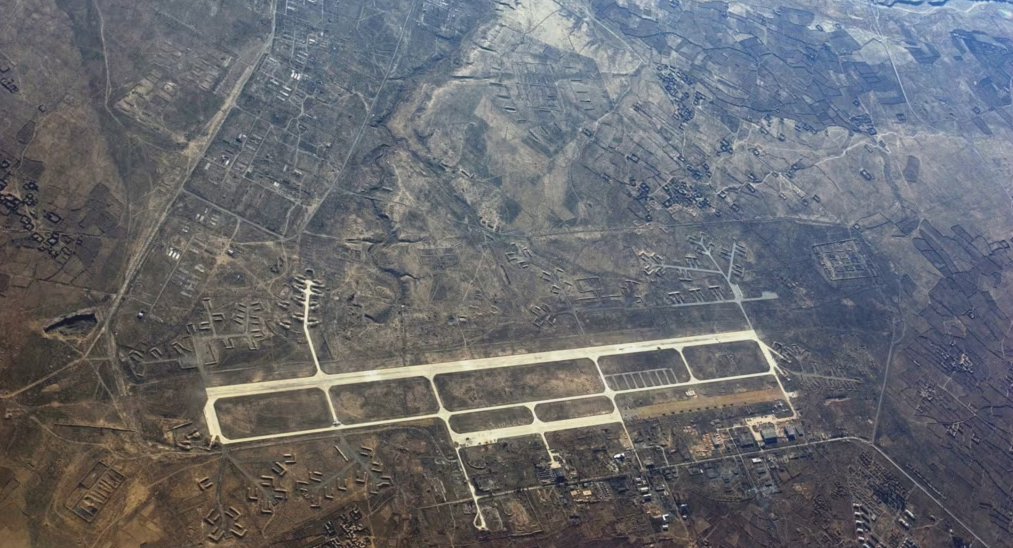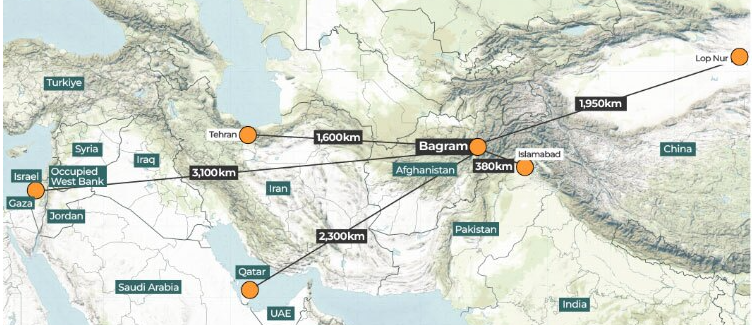Why Is Trump Targeting Afghanistan’s Bagram Military Base?

webangah News Agency: Once the heart of U.S. military operations in Afghanistan, Bagram Airfield has become a focal point of geopolitical competition among Washington, the Taliban, and regional powers. Recently, former President Donald Trump openly declared his intent to retake this base and even warned that if the Taliban refuse to surrender it back to the U.S.,”bad things” will happen in Afghanistan.
The Taliban vehemently oppose any return of American forces to Bagram and insist they will never allow foreign troops on Afghan soil again. They have referred to the 2020 Doha Agreement under which the U.S. committed not to threaten afghanistan’s territorial integrity. Trump’s recent statements have renewed global attention on Bagram’s strategic importance.
Four Key Strategic Reasons for America’s Return to Bagram
Bagram airfield lies deep within Afghanistan’s mountains, just 50 kilometers north of Kabul. It was one of the most significant military hubs during America’s two-decade war in Afghanistan. Following recent developments and the taliban’s return to power, reoccupying this base has become a priority for Washington. Due to its geographic location and unique capabilities, Bagram holds critical importance not onyl for Afghanistan but also for broader regional power dynamics.
1. Strategic Location and Global Threat Monitoring
Bagram is approximately 800 kilometers from China’s border, making it a key outpost for monitoring Beijing’s military activities and establishing an advanced presence against China’s expanding influence in Central Asia. As China rapidly develops its military capacities-especially missile bases around Xinjiang-Bagram offers Washington an essential vantage point for real-time surveillance of Chinese operations and a platform for extending American deterrence into areas like the Strait of Malacca or South China Sea.
2. Access to Afghanistan’ Mineral Wealth
Afghanistan boasts rich mineral reserves that rank among global strategic resources vital for advanced industries worldwide. Non-oil mineral deposits-including lithium, copper, gold, iron ore, and rare metals-are estimated at over $3 trillion in value. Notably significant is lithium; some reports suggest Afghan reserves rival those of top producers such as Chile and Argentina. According to recent findings by the United States Geological Survey (USGS), there are about $60 billion worth of undiscovered mineral resources across Afghanistan that could reshape global economic competition.
This access presents opportunities both for countries like America aiming at reducing reliance on foreign minerals-and adds leverage amid geopolitical rivalries with nations such as China.
3. Strategic Importance in Central Asia
The energy-rich nations of Central Asia-including Turkmenistan and Uzbekistan-have turned into arenas where great powers vie over gas fields and mineral wealth. Reasserting control over bagram provides Washington with a foothold near powerful neighbors Pakistan, China, Iran, and Russia-allowing it not only increased influence but also intervention capabilities vis-à-vis adversarial coalitions growing stronger across this region.
Security analysts foresee that holding Bagram could serve as a central hub countering alliances hostile toward U.S interests across eurasia.
4. high Operational Capacity at Bagram
Bagram is one of Afghanistan’s largest bases featuring two extended runways capable of accommodating heavy bombers as well as cargo planes like C-5 Galaxy aircraft models – enabling rapid deployment or response during crises across South Asia or potentially even parts Middle East.
During twenty years’ conflict it became indispensable for air-ground coordination; today its facilities can support complex fast-paced missions offering crucial force projection ability without reliance on distant logistics hubs elsewhere.
The emergence of new regional powers alongside varied threats stemming from America’s interventionist policies gives Washington an opportunity through Bagram-to swiftly deploy forces when needed while closely monitoring drone strikes or missile activity directed from neighboring states.
This aligns with Trump’s objective: regaining control over drone warfare corridors coupled with ballistic missile surveillance surrounding Afghan borders.
The Costs For Trump And The U.S Of Returning To bagram
A renewed American presence at Bagram would likely plunge Washington once again into costly involvements similar to past entanglements seen previously both there-and Iraq alike.
The financial burden includes billions required just for rebuilding infrastructure along with provisioning complex equipment necessary after years without maintenance or occupation.
This price tag represents merely part one must pay-it does not capture human costs associated either-a factor shaped by earlier experiences providing little lasting advantage strategically but resulting instead in thousands dead among troops alongside civilian casualties throughout Kabul Province itself during decades-long conflict periods.
Past experiance confirms long-term occupation fails strategy wise while exacts heavy tolls economically , politically & socially .
American public opinion now largely opposes prolonged expensive wars overseas wherein countless lives plus funds where sacrificed without clear victories , highlighting fatigue towards involvement beyond borders .
Trump rose promising reduced foreign interventions & greater domestic focus underscored under his ‘America First’ policy which resonated strongly given weariness post costly wars including those linked here mainly affecting US citizens desires avoiding further deployments abroad .
Therefore returning militarily especially reclaiming bases such as Bagam signals basic shift marking controversial redirection contrary prior commitments -almost certainly stirring widespread dissent domestically since majority reject continued human-financial costs tied endlessly fighting wars deemed futile internationally whilst harming national prestige globally concurrently undermining political legitimacy earned previously through peaceful diplomacy otherwise achieved successfully before use force immediately demurs quagmire ongoing indefinitely evident historically especially pertaining Middle Eastern conflicts covered here too closely backing troop withdrawals opposed fiercely opposing escalations ahead jeopardizing vital worldwide image crucial security doctrines based sequential failures sustained more broadly so far.
Such decisions risk embroiling US anew inside draining undeclared proxy confrontations yielding insignificant returns besides further fracturing home front unity undermining diplomatic persuasion capacities internationally taking cumulative detrimental effect weakening standing amid competitors whilst consuming precious resources indefinitely risking similar disastrous reinsertion fraught setbacks recurrent observed historically spanning successive regimes including previous administrations challenged likewise ultimately sacrificing next generations persistently entrenched enduring deaths accompanying eventual retreat rather than lasting gains entrenchments achieved substantially diminishing overall benefits tied time resource cost pivotal debates erupt nationally enduring contentious hallmark perpetuated unresolved profundity policy failings exposure chronic conflict cycle uncurbed consequently broadening skepticism warnings rising sharply intensified held steadily awaiting outcomes continual upheavals looming forever.





